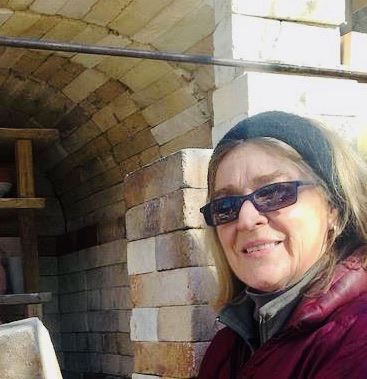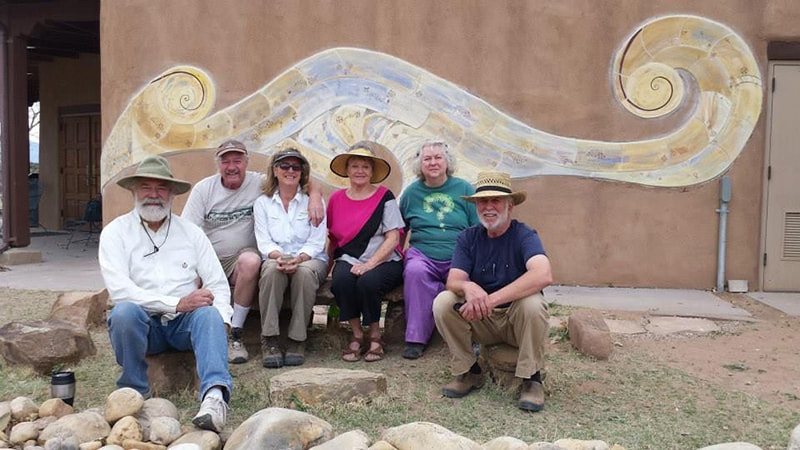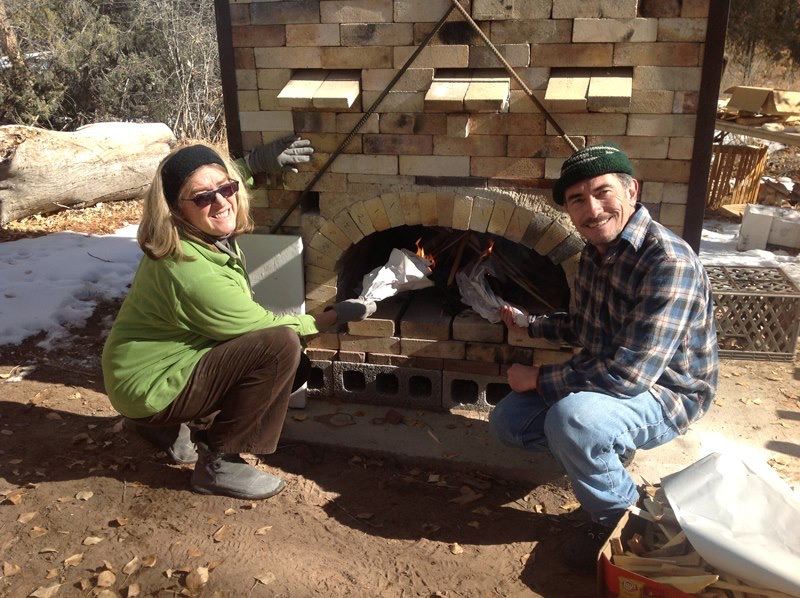|
~Cirrelda Snider-Bryan New Mexico Potters and Clay Artists Barbara Campbell currently serves as the Ceramic Arts Coordinator at Ghost Ranch Conference Center north of Abiquiu, NM. Here is the story of her life in clay and her work with it at Ghost Ranch. The Slip Trail: Tell the story of how you came to be a clay artist. Along with that, tell how you became a production potter living in El Rito, NM. Barbara Campbell: Between high school and college, I took a year long trip to Europe. At the time I spoke passable Spanish and enough French to get into trouble, but I really liked languages so off I went. While living in Paris I honed my French and started learning a bit of German. When I returned to attend college, I thought I would like to be a foreign diplomat, so I started taking Russian and going after my Bachelors, still fooling around with this direction. In my third quarter of college, I took a pottery class and got totally snagged. I think part of my decision to transfer to an art school was that my mother went to an art school in the Bay Area, and I had a boyfriend in the Bay Area so it was an easy decision to transfer. My education became very non-traditional very quickly. The boyfriend disappeared and I was sent by my college to a rural village in Mexico to help set up a branch campus there. It was an amazing experience and I learned to be more of a self-starter. We had to do everything without much mature adult supervision. It was a fabulous experience. I had to return for my final semester to the Oakland campus and there I worked with Viola Frey. Once out of school, I headed off to NYC and got a job teaching pottery at the Cooper Square Art Center. I only lasted about eight months in NYC before I felt I was completely losing myself. I took a three-day train ride back to San Francisco and joined the Berkeley Potters Guild and from there went full into production pottery. About this time the powers that be were demolishing all the old Victorian homes in Oakland and I started making little houses out of clay. This sort of took off and I got into all sorts of different styles of house replicas and fantasy castles and planters and it became very popular to the point I was supplying shops all over the country. I had patterns for certain styles so just started cranking out the work. Berkeley decided it needed the area where our guild was located for a redevelopment project. It never actually happened, but they gave us all about $2,000 to move. I used mine to invest in all the equipment I would need to set up my own studio. I had a friend who got the same and we moved into a caretaking position up in Jenner, and he helped me build a downdraft gas kiln before moving on to his own place up near Fort Bragg. I saved up my money that year and found a property I could afford in Sebastopol, CA. I lasted there for four and a half years when I was missing the mountains and blue skies of the Rockies where I had grown up. I sold my house and moved everything except my huge kiln to Boulder, Colorado where I had grown up. I couldn’t find what I was looking for anywhere in Colorado, but I had an opportunity to drive a friend to New Mexico. I did a search when I got here in early 1978. I found and house in El Rito and made an offer on it that was accepted. I moved from Boulder on Easter weekend of that year. About a week after setting up my studio, I met a guy right here in El Rito and we were married about a year later. His property and my house were really inconveniently located so after a big show, I had enough money for us to go together and buy a property in the middle of town. We had this town property and the property up the Potrero canyon. I built a studio up there and had the one in town so we were able to come back and forth while raising our son. The town property was crucial for when he started going to school. Meanwhile when my son was about three years old, I can remember hating making these stupid little cookie cutter houses and one morning I woke up and decided I would never make another little #%$* house. I got my wheel out and started honing my throwing skills. I had been fascinated with the Mimbres culture from the moment I got to NM. I wasn’t able to find a lot of information about them and the two or three books that were out there all seemed to contradict one another. I started collecting their very graphic wonderful designs. About this time, I had to paint my window frames and doors on the house we had bought in town and my neighbors said I had to use this certain color of teal as it was what would keep the brujos away. So here I am an Anglo living in a Hispanic community thinking about using Native American designs on my pottery. As I was designing this line of work, I needed to get the Hispanic element into the dinnerware I was preparing to make. I worked on the blue slip recipe from Daniel Rhode’s book until I got a really deep lovely teal. Now I had the tri-cultural intention working for me. The Slip Trail: I remember you selling your pottery at Ghost Ranch in the 1990s at the local craft market held on Friday evenings. What was that like? Barbara Campbell: Somewhere around the mid 80’s I started selling my work at the Mercado on Friday evenings at the Ghost Ranch. It was a captive audience and very lucrative. That is what I spent my summers doing every Friday evening for about ten weeks per summer. I did American Craft Council shows as well as small local shows and managed to make a reasonable living. The Slip Trail: You were hired for the Ghost Ranch ceramics education coordinator position in the early 2000’s, was that first year a full schedule? As you come close to teaching there 20 years, what has changed? Barbara Campbell: I wasn’t hired, I was asked to volunteer. Around 2004, Jim Kempes, who was the Arts Coordinator and main ceramic artist running Pot Hollow at the Ranch, decided to go into grade school teaching and left the Ranch. I had been on the board that runs the Mercado at the Ranch and I was asked to take over the Ceramic Arts department. By that summer or the next, I started teaching several classes during Festival of the Arts. Soon I was teaching Jan Term as well. When asked if I would be coordinator for the ceramic arts program, I wanted to know what it involved. They said, “A lot of work and no money.” I said, “Sure, why not.” There was an Interim director named Mary Ann Lundy. Judy Nelson-Moore and I actually initiated doing some renovations with Pot Hollow. We went to Mary Ann Lundy and made a proposal that we have a volunteer camp. And so we did. That was the beginning of V-camps. First of all, all the wheels were on tiny pads of cement that were sticking up and one would trip over them all the time. If you dropped a tool it went into the dirt or the sand and if you didn’t pick it up right away it got stepped on or lost. It was pretty funky down there in Pot Hollow. So, the Potters Association raised enough money to pour a slab and that was the beginning. Then, there was this program coordinator named Jim Baird. I had been told the best way to approach him if you wanted anything was to kind of come in from the side, so he felt like it was his idea in the end. So, I kinda got good at that. There was no cover over the two raku kilns and trolley kiln. You know the tubes that ran the gas were in the sun. In the winter they were in the snow. We suggested that the Ranch put up a pavilion roof. And they did, that was the result – the Ranch paid for that. The Potters Association raised enough money to do the cement. Then Potters raised enough money for half of the big gas kiln, the West Coast 24 cubic foot gas kiln. The Slip Trail: The one that’s there today? Barbara Campbell: Yeah, just got repaired this year. It’s now functioning perfectly well with one glitch, that’s just a get-it-going glitch, the electronic ignition doesn’t actually work because the striker doesn’t work, so somebody has to be there to do the switches while somebody’s under the kiln with a torch. There are eight burners. You just have to keep working at getting it going. The gas doesn’t seem to flow well at first. But once it gets lit it works, it goes up to cone 10, in 6-8 hours. Almost every year after that, we did a volunteer camp where the potters would come and renovate, repair and take inventory. One year we had this woman named Judith Baker who took the class and really loved it. Her husband was quite wealthy and he made a nice donation to us. I asked him if he would buy these Advancer shelves for us because I was getting to the point where lifting heavy things into the back of the kiln was becoming too hard for me. There was a potter in El Rito who was going out of business. He had 16 of these shelves, and he sold them to us for $1200, which is a third of what they would cost new. We now have all these lovely Advancer shelves compliments of the Baker’s. So, it turned out, somewhere in the 90s, somebody else made a donation. It could have been the Bakers. I can’t remember. But anyway, I didn’t know about it until this year. Apparently, what the Ranch did in the meantime was to invest it, earmarked for the ceramic arts program. It has now earned to around $28,000. Then Debra Hepler came along and she was there ten years. Tom Nichols who ran the welding department wanted to put together a Peace Garden in honor of Barbara Schmidtzinsky, Archivist and Assistant Program Director, who had recently lost her battle with cancer, and Ed Delair, Program Director, who had died suddenly of a heart attack. From the patio at Headquarters, you can’t really see the Peace Garden down at Lower Pavilion, so we had the idea that if we put a mural that reflected those Fibonacci spirals in the Peace Garden, it would draw people down to the Peace Garden. Dean Schroeder, Tomas Wolff, Judy Nelson-Moore, and I got together to plan it out. Judy and I did the design and decal work -- Judy, Dean and I did the tile work. Then Tomas and Dean installed it with the help of Tom Nichols and some help from me and Judy. We had this tiny little 12 by 18” slab roller and it was not big enough. Michael Walsh who lives in Santa Fe had a 4' by 24" Brent Roller and he was willing to sell it to the ranch for $800. It was in new like condition and Debra gave me permission to have the Ranch buy it for us. We sold the little one to Mountainair for 100 bucks which went back to the Ranch. The Slip Trail: I would say 800 for a huge slab roller, that’s a great price. Barbara Campbell: That’s what I told her. Debra got to the point where I would start walking up to her and she would kinda go like this [hands up] and go, “How much is this gonna cost me?” I would say, “Well, not too much!” Anyway, she was very helpful for getting equipment we needed for pulling things together. I had this big wood fire kiln up in Potrero. The reason I built it up there was because we always had these piles of brush that needed to be burned. It was oak, it was the wrong fuel for a kiln. I could never get up to cone 10 -- it was just like really, really difficult. The oak would make clinkers, you know it would make coals, then it would stall the kiln and I would have to rake the clinkers out and get the fire going. So, I just quit firing it. And at one point, after Terry died, Colin said, “Mom, what do you want to do with this kiln?” I said, “I want to move it to Ghost Ranch.” So, we got several people together, there were 6 or 7 of us. We took that kiln apart. Loaded it onto the Low Boy trailer, and made two trips over to the Ranch. It was way too heavy for one trip. I offered a course on “How To Build a Wood Fired Kiln.” We had four students - two of them were not pulling their weight, the other two were really into it. I had to keep taking stuff apart and rebuilding it. It was somewhat frustrating; however, in a week’s class we rebuilt that kiln. So, I decided it needed four feet more stack. One of the reasons it wasn’t firing correctly was because the stack wasn’t high enough. I went down to Santa Fe Steel (the Potters Association raised the money for this, I think it was 400 or 800 – I can’t remember --somewhere under $1000). Then my son rented a cherry picker, and my brother-in-law and my son brought the cherry picker and installed it on top of the other piece that we already had in place. We now had 11 feet of stack. I had previously fired it once or twice with a few people and we were just stoking and stoking it, it was insane and it was hard. It was also very aerobic. I still wasn’t happy with the way the temperature was so uneven. So, I called Betsy Williams and she said, “I will come over and help you.” We were getting mill ends from Moore’s Lumber Company, so when the guys from the Ranch would take the recycle into Espanola, they would stop at Moore’s and pick a couple of these huge bundles for 30 bucks, deliver them to the Ranch. Potters Association people would come saw it up into two-foot pieces. There was lots and lots of firewood. Well, for two-fifths of a cord of wood, cut into two-foot pieces, Betsy showed me how to fire the kiln gently. When the pyrometer started to go back down, you throw two pieces in and it will keep going down, and then it will start going up a little higher. The minute it would start to come down again, throw two more pieces in. It was so civilized and it was so easy, and could easily be done with just two people. We didn’t need four teams of people to take turns, we just needed a couple people in an easy chair or two out there, and some lemonade or cold water. It worked beautifully. We got to cone 10 in 8 hours and it was fabulous. With this technique, we did two or three workshops. We could go from clay to wood-fired, finished pieces in less than a week. It was amazing. The Slip Trail: I am so glad this story is being told. To be continued Next week ...
3 Comments
ROGER J CAOUETTE
10/7/2023 09:56:18 pm
great story. thanks
Reply
10/13/2023 12:43:18 pm
Wonderful to learn all this, Barbara. Glad the story's being told!
Reply
Nancy Coble
10/14/2023 08:25:44 am
Barbara, thank you for sharing your story. I purchased a couple of your pottery( bowl and jar) items years ago at Ghost Ranch and they are my favorites in my collection of pottery over 50 yrs. I hope to get back to Ghost Ranch in 2024.
Reply
Your comment will be posted after it is approved.
Leave a Reply. |
Submit your ideas for local feature articles
Profiles Gardening Recipes Observations Birding Essays Hiking AuthorsYou! Archives
October 2025
Categories
All
|





 RSS Feed
RSS Feed